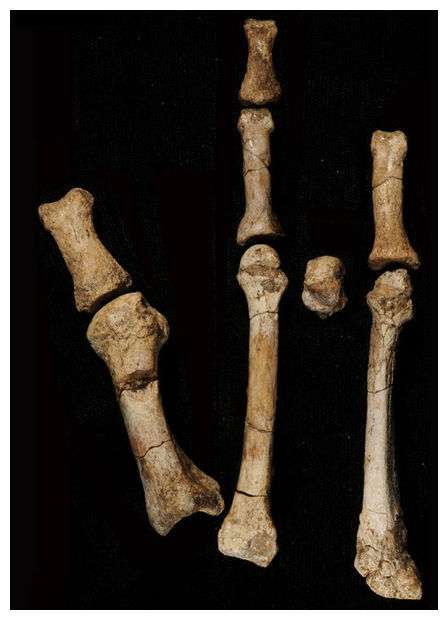
Lucy was not alone. The discovery of a remarkably rare partial foot from an ancient primate suggests that more than one kind of human ancestor walked upright in Africa when Lucy's species, Australopithecus afarensis, was alive. The primitive traits in this 3.4-million-year-old partial right foot also show that there was more than one way for early human ancestors to walk upright for at least a million years, according to a new study.
Ever since the discovery of Lucy's species in 1974, she has been considered a prime candidate for a direct human ancestor. Unlike earlier apes, Lucy walked fully upright, even though her brain and body weren't much bigger than a chimp's. This showed researchers that bipedal walking was a key trait of humans and our ancestors, the group called hominins - but not of living apes and their ancestors.
Researchers have long wondered if other upright walking species shared the Rift Valley of Africa with Lucy, particularly after they discovered that several types of hominins were alive at the same time after A. afarensis disappeared 3 million years ago. Paleoanthropologists have found the bones and teeth of hundreds of individuals of A. afarensis from between 3 million and 4 million years ago. But in that time period, only one other potential hominin, Kenyanthropus platyops, has turned up, and its skull was so badly crushed that researchers disagree whether it represents Lucy's kind or a new species.
Meanwhile, scientists who study the evolution of walking have had to make do with only a few glimpses of ancient feet from this time because the foot's delicate bones are rarely preserved. Most agree that Lucy's foot and mode of walking were already quite modern, thanks to a few 3.2-million-year-old foot bones from A. afarensis adults, a 3.3-million-year-old infant, and 3.7-million-year-old footprints in Tanzania, thought to be made by the same species.
So the discovery of eight ancient bones from another foot is "a really important step in our evolution of the human gait," says paleoanthropologist Brian Richmond of George Washington University in Washington, D.C., who is not a co-author.
Found protruding out of the eroding sandstone at Burtele, in the central Afar region of Ethiopia just 45 kilometers north of Lucy's homeland, the bones provide hard evidence that two different hominins walked upright in two different ways 3.4 million years ago. The six lateral toe bones have traits that indicate they were used to walk upright, making the joint between the bones of the foot and toes (the metatarsophalangeal joint) flexible enough that the toes could be used to push off the ground.
But this foot also has primitive traits. It lacks an arch and has an opposable, or grasping, big toe, like living apes, says Yohannes Haile-Selassie, a paleoanthropologist at the Cleveland Museum of Natural History in Ohio and the lead author of the new study, which appears online today in Nature. These traits make the foot more similar to those of ancient apes and an earlier upright walker, Ardipithecus ramidus (aka "Ardi"), which lived 4.4 million years ago in Ethiopia, than to Lucy's foot. In fact, co-author Bruce Latimer of Case Western Reserve University in Cleveland, Ohio, says that when Haile-Selassie first showed him the toe bone, "I said, 'It's another Ardi.' " When Haile-Selassie told him it was a million years younger than Ardi, Latimer said, "No, that can't be!"
These primitive traits in an upright walker suggest that the new foot might represent a late-surviving remnant of Ardipithecus, says Haile-Selassie. He declines to name the species, though, because no teeth or skull bones were found to help identify the foot's species. Whatever its name, others agree that the foot is unexpectedly primitive for 3.4 million years ago: "I would have expected such a foot from a much older hominin, not one that overlapped with A. afarensis, which has a much more derived foot than this thing," says paleoanthropologist Jeremy DeSilva of Boston University, who is not a member of Haile-Selassie's team.
The anatomy also suggests that although this hominin walked upright, it moved awkwardly because of the grasping big toe. It could not run upright or venture far from the trees where it likely took shelter at night, says Latimer. "This foot, therefore, provides some of the best evidence that there were different experiments in bipedalism going on during this time in human evolution," says DeSilva.



Reader Comments
to our Newsletter